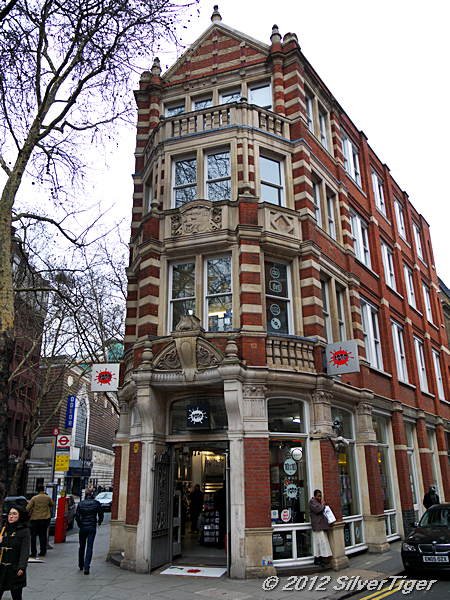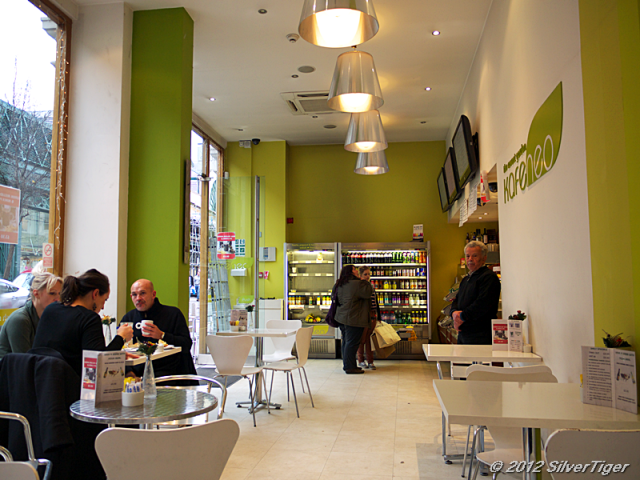Back in November, we had been to Covent Garden to visit the London Transport Museum (see Breakfast, a museum, a ramble and a visit to the Dead House) and our tickets entitled us to unlimited visits for a year, so today we thought it was time to return there for another look.

Number 1 Earlham Street
What is its history?
We got off the bus in Shaftesbury Avenue and I took a photo of this handsome corner building at the junction of Shaftesbury Avenue and Earlham Street. Today, it’s ground floor is occupied by Fopp and I think the upper floors are apartments. I am curious to know its history but have not been able to find out anything about it.

Artisan at work
Does this provide a clue?
A possible clue appears in a moulding above the door of Fopp. This shows what seems to be a Tudor artisan at work (I like the way his right leg is hooked around the leg of the stool), though the building is not Tudor, of course. Neither of us can identify the activity in progress and if any reader can do so, I would be interested. Perhaps the scene refers to a workshop that existed on the site before the present building.

Monmouth Street, Covent Garden
Looking towards the Seven Dials Monument
We walked along Tower Street to Monmouth Street. The above photo shows a view up Monmouth Street to the Seven Dials Monument. Seven Dials was laid out in a star formation to a design by Thomas Neale (1641-99) and built between 1693 and 1710. Google Maps mistakenly labels the southern part of this street ‘Upper St Martin’s Lane’ and I here append proof of the correct designation. (Bing Maps gets it right, though.)
Covent Garden is still an area of narrow streets, courts and yards. (for example, there is Neal’s Yard, named in honour of Thomas Neale.) Most date from ancient times but, increasingly, there are new developments.

St Martin’s Courtyard
Accessed through Slingsby Place
Such a one is St Martin’s Courtyard, a new open space surrounded by shops. It may vaguely resemble some of the other friendly courts where people hang out among “alternative” shops and cafes but this is a high street shopping centre with upmarket boutiques, not “Covent Garden” in spirit at all.

Wow Retro
Occupying Chertsey Cambers, Mercer Street
We carried on through to Mercer Street where the intriguing shop WOW RETRO occupies the equally intriguing building named Chertsey Chambers. WOW RETRO, as the name suggests, sells secondhand clothing, and some furniture, in styles going back as far as the 1920s. A good place to browse if you want something for a fancy dress party or simply like wearing retro garments.

Chertsey Chambers
A late Victorian commercial block
At a guess we think this building, with its slightly severe design relieved by a few decorative curlicues, dates from late Victorian times. I have found a reference to a business renting cellar space here in 1901 which suggests mixed usage. Today there is a music theatre company in residence among other businesses.

Ghost sign
On the corner of Mercer Street and Long Acre
Mercer Street led us onto Long Acre which takes its name from when it was a strip of cultivable land owned by the monks of Westminster Abbey. Today, after many ups and downs, it is Covent Garden’s main shopping street. The view along it is dominated by the Freemasons’ Hall (built 1775).

Long Acre
With Freemasons’ Hall in the background
Turning into James Street at Covent Garden tube station (opened 1907), one comes to what is now called the Piazza and was once London’s main fruit and vegetable market until 1973 when it was relocated at Nine Elms.

The Piazza
One of the passageways
The Piazza is a centre for shopping and entertainment, particularly entertainment by buskers who play music, perform comedy routines and novelty acts. They are not above buttonholing passers-by and drawing them into their acts.

He offered to pose…
…but I preferred to catch him on the hop
I photographed this busker in front of the London Transport Museum. He offered to pose for me but I preferred to catch him as he was performing.

Kafeneo
A coffee and snack bar near the Piazza
Tigger fancied a drink before going into the museum so we went to Kafeneo in Tavistock Street. It’s quite a pleasant place and handy for the Piazza and the museum.

Entering the Museum
Old building, modern decor
There was a queue for admission to the museum but because we had tickets we could go straight in. The entrance is self-consciously modern and sci-fi-looking but fortunately, having let their imaginations run riot on this bit, the designers calmed down and the rest of the museum decor is unobtrusive as it should be in order to give full value to the exhibits.
There is a lot to see here, not only in the form of a priceless set of exhibits but also in displays of information in various formats – audio, film, posters, touch-screens, etc. Exhibits cover London transport from the ancient…

A happy conductor…
…aboard a horse tram
…to the ultra-modern (this one hasn’t even entered service yet):

Emirates Air-Line gondola
London’s first cable car service
Emirates Air-Line (a rather ambiguous name) is a cable car service – London’s first – that will provide a new Thames crossing, linking stations on the Greenwich Peninsula and the Royal Victoria Docks. Both pedestrians and cyclists will be carried. The service is due to start in the summer of this year.

An age-old drama
A busker performs
When we at last emerged from the museum, the sky had darkened and lights were blazing in the piazza. In the yard, an age-old drama was in progress – a busker had attracted an audience and was performing his routine.

“Do you believe I can do it?”
“Hands up if you think I can”
Bare-chested and almost painfully thin, he waves a stringless tennis racquet and asks whether the spectators think he can wriggle the whole of his body through it. “Hands up if you think I can.”

Racquet raised…
…and the ritual begins
Whatever else you might say about him, this young man knows how to gather and hold an audience. There is suspense in the air as they await the outcome and yet it is obvious he will succeed. He is not going to raise such a pitch of expectation only to admit defeat.

The Lamb and Flag
Seen here in its night-time aspect
We did not wait to see the inevitable outcome but continued on our way and went along Rose Street, past the Lamb and Flag, also known as The Bucket of Blood (see The last walk of the year), looking somewhat more dramatic at night.

Monmouth Street at night
Dressed in Christmas lights
This time we walked up Monmouth Street, which was prettily illuminated with Christmas lights, as were the neighbouring streets, and reached the Seven Dials Monument.

A facsimile of the original
How many dials do you see?
When Seven Dials was planned, a monument marking its centre was included, bearing sundials around the top, but there was straightaway a mystery. Where the monument stands, seven roads converge and you would therefore expect there to be seven dials, one for each street, and consistent with the name. However, there are only six. Why?
I don’t think anyone knows the certain answer to that. It has been suggested that the original plan envisaged only six streets and that when this was increased to seven, the design of the monument was left unchanged. Another suggestion is that two of the streets enter at a closely similar angle so that one dial does for both of them. We shall probably never know the true explanation.
Despite the area being intended as an elegant district for the gentry, its fortunes declined so that by the later 18th century it was the haunt of criminals and prostitutes with the monument acting irresistibly as a meeting point. In a forlorn attempt to ameliorate the situation, the authorities pulled down the monument in 1773. That, however, was not quite the end of its story.
James Paine, the architect, living in Sayes Court, Addlestone, had the pieces removed to his garden there. Then, in 1820, a public subscription was got up by the citizens of Weybridge to raise a monument to Princess Frederica, Duchess of York, who died in August of that year. The old Seven Dials Monument was bought and reused for the purpose, though a coronet was substituted for the dials.
The present monument at Seven Dials, an exact copy of the original, was installed in 1989 as part of a programme of renovation of the area. We may thus admire it again today and continue to ponder the conundrum of the six dials.
Copyright © 2012 SilverTiger, https://tigergrowl.wordpress.com, All rights reserved.





The “Emirates” in “Emirates Air-Line” suggests to me that there is United Arab Emirates money behind it. The middle eastern lot have used their oil money as capital to invest in real estate and businesses throughout the world. And when you think about it, a cable car has a literal “air line” — the cable. The “Chambers” of “Chertsey Chambers” suggests legal offices to me. But then it could refer to “chambers” in the sense of “rooms.” There is also a certain amount of alliteration involved. The building at 1 Earlham street has an interesting use of variously colored bricks. Wedge shaped buildings of that sort are fascinating to me as to what the layout of the rooms inside would be like and how the floor plan would cope with the overall “wedge” dimensions of the building. Clueless about what the man in the molding is doing, although it seems to involve a frame with hooks that have something hanging from them (tenterhooks?). If we knew what the object in the right lower corner was — One thing that came to mind was parchment making. If it’s made from skins, they would have to be stretched somehow. There seems to be a sheet of something in the right corner as well. The Seven Dials holiday lights are interesting from a strictly decorative point of view — They’re nice to look at, and are completely devoid of any sort of religious symbolism. A creative solution to the seeming necessity of politically correct holiday decorations — they don’t even use any “Christmas” colors (red, green). The far right Covent Garden face made me LOL.
LikeLike
Yes, the “Air Line” is being financed by the Emirates airline company and as a reward, the station names will all start with the word “Emirates”, something that many of us deplore.
The word “Chambers” often appears in the names of older buildings in London without this necessarily indicating a connection with the legal profession. I think barristers’ chambers are all within the various Inns of Court and refer to the firms rather than the buildings themselves.
Tigger is also intrigued by wedge-shaped corner buildings which in turn makes me notice them. It would be interesting to look inside this one and see how the living quarters have been adapted to the shape.
Perhaps a knowledgeable person who can interpret the artisan plaque will yet come forward.
LikeLike